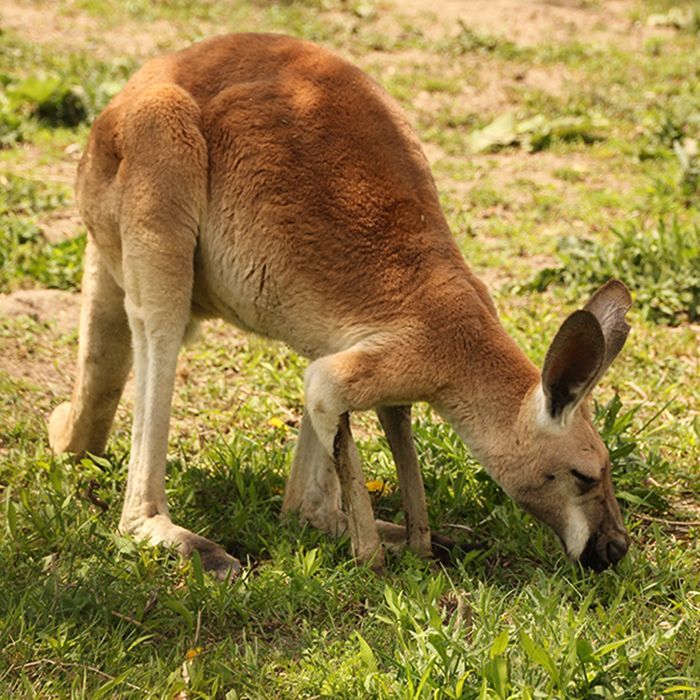GET THE SAFARI SCOOP!
Thank you for contacting us.
We will get back to you as soon as possible.
We will get back to you as soon as possible.
Oops, there was an error sending your message.
Please try again later.
Please try again later.
Red Kangaroo
The red kangaroo is the largest member of the kangaroos and is also the largest living marsupial. They are widespread throughout central Australia in areas of low rainfall and are considered Australia’s largest terrestrial mammal. They are appropriately named the red kangaroo due to the red-brown colouration of the male’s fur. Females on the other hand are often a blue-grey colour. They have excellent senses of sight, hearing, and smell and are mostly crepuscular and nocturnal, often resting in the shade during the day. Red kangaroos are the largest marsupials on the planet and are sexually dimorphic. The males are much larger than the females and have distinct red-brown colouration, while the much smaller females are typically grey. Red kangaroos can stand up to 1.5 m (5 ft), while mature males can easily stand over 1.8 m (6 ft). Females can weigh up to 40 kg (88 lb) and males can weigh over twice that, up to 90 kg (198 lb). Kangaroos are very strong animals that can reach speeds up to 65 km/h and can leap as far as 8 meters and as high as 3 meters.
Red Kangaroos are primarily nocturnal and are strict herbivores that frequently graze on both fresh and dried grasses, and will also consume flowering plants and succulent plants, the latter of which will provide them with additional water. Their primary source of water will also be their food, as they can extract the remaining moisture from even a dry plant. Due to the scarcity of nutritious food in the arid regions, they inhabit, kangaroo populations are highly sensitive to alterations in their environment, as periods of drought and intense heat can deplete what little food is already available.
Red kangaroos are native to Australia and are primarily found throughout central and western Australia, often preferring expansive desert, grassland, and scrubland habitats. They will often seek out trees for shade purposes and will acquire their water through the vegetation they consume, even when the plants are dry. As desert animals, they have a natural adaptation of conserving water by concentrating their urine thereby minimizing water loss. Many kangaroos will often prefer to graze and travel through a familiar home range but may travel up to and over 30 km when food becomes more scarce.
Red kangaroos follow a polygynous system of reproduction and will breed all year round. The males will often fight to establish dominance and breeding opportunities with females. After breeding occurs, the female will become pregnant for 33 days before a tiny joey is born that will be only 2.5 cm long and weigh less than a gram. The joey will be blind and hairless and will crawl up the mother’s pouch to begin nursing on milk. The joey will grow rapidly and after approximately 190 days, the joey will emerge from the pouch more and more each day, until finally at around the 230-day mark, the joey will be permanently outside of the pouch but will not be fully weaned until 12 months of age.
Female kangaroos are known for their highly effective reproduction, as they are capable of having several generations of offspring at the same time, largely due to their ability to undergo embryonic diapause, a reproductive strategy in which the female can essentially freeze a fertilized zygote before it attaches itself to the uterus. Using this method, it is common for female kangaroos to have a larger joey that is outside of the pouch and nursing, a younger joey that is still in the pouch and suckling, and also a fertilized zygote in a suspended state, that will be ready to implant once the pouch becomes available. As a result, female kangaroos have been known to be in a permanent state of pregnancy and motherhood. Once born, Red kangaroos will often endure a lifespan of approximately 25 years, with some individuals reaching upwards of 30.
Red kangaroos are highly social animals, with most “mobs” consisting of around 10 individuals, although they have been known to congregate in groups far larger than this in areas where food is plentiful. The mobs are usually made up of mostly females and their offspring, along with a few mature males. The males are not territorial with one another in the classical sense but will compete for breeding opportunities with the females. During these encounters, males will spar or box with one another in which they will strike with their paws and kick with their hindlimbs. This is possible due to their extremely powerful tails that they can balance on. Kangaroos of all kinds will often rely on their olfactory centre as a means of communication. Sniffing will occur between individuals as a means of acquiring information about one another, with the more submissive of the 2 individuals often maintaining a lower posture than the other. Most of this behaviour will occur between males and females, and females and their offspring. Male kangaroos may also communicate through gestures and body language, such as thumping their tail on the ground to signal danger or puffing out their chests to establish dominance over a potential rival.
Red Kangaroos are primarily nocturnal and are strict herbivores that frequently graze on both fresh and dried grasses, and will also consume flowering plants and succulent plants, the latter of which will provide them with additional water. Their primary source of water will also be their food, as they can extract the remaining moisture from even a dry plant. Due to the scarcity of nutritious food in the arid regions, they inhabit, kangaroo populations are highly sensitive to alterations in their environment, as periods of drought and intense heat can deplete what little food is already available.
Red kangaroos are native to Australia and are primarily found throughout central and western Australia, often preferring expansive desert, grassland, and scrubland habitats. They will often seek out trees for shade purposes and will acquire their water through the vegetation they consume, even when the plants are dry. As desert animals, they have a natural adaptation of conserving water by concentrating their urine thereby minimizing water loss. Many kangaroos will often prefer to graze and travel through a familiar home range but may travel up to and over 30 km when food becomes more scarce.
Red kangaroos follow a polygynous system of reproduction and will breed all year round. The males will often fight to establish dominance and breeding opportunities with females. After breeding occurs, the female will become pregnant for 33 days before a tiny joey is born that will be only 2.5 cm long and weigh less than a gram. The joey will be blind and hairless and will crawl up the mother’s pouch to begin nursing on milk. The joey will grow rapidly and after approximately 190 days, the joey will emerge from the pouch more and more each day, until finally at around the 230-day mark, the joey will be permanently outside of the pouch but will not be fully weaned until 12 months of age.
Female kangaroos are known for their highly effective reproduction, as they are capable of having several generations of offspring at the same time, largely due to their ability to undergo embryonic diapause, a reproductive strategy in which the female can essentially freeze a fertilized zygote before it attaches itself to the uterus. Using this method, it is common for female kangaroos to have a larger joey that is outside of the pouch and nursing, a younger joey that is still in the pouch and suckling, and also a fertilized zygote in a suspended state, that will be ready to implant once the pouch becomes available. As a result, female kangaroos have been known to be in a permanent state of pregnancy and motherhood. Once born, Red kangaroos will often endure a lifespan of approximately 25 years, with some individuals reaching upwards of 30.
Red kangaroos are highly social animals, with most “mobs” consisting of around 10 individuals, although they have been known to congregate in groups far larger than this in areas where food is plentiful. The mobs are usually made up of mostly females and their offspring, along with a few mature males. The males are not territorial with one another in the classical sense but will compete for breeding opportunities with the females. During these encounters, males will spar or box with one another in which they will strike with their paws and kick with their hindlimbs. This is possible due to their extremely powerful tails that they can balance on. Kangaroos of all kinds will often rely on their olfactory centre as a means of communication. Sniffing will occur between individuals as a means of acquiring information about one another, with the more submissive of the 2 individuals often maintaining a lower posture than the other. Most of this behaviour will occur between males and females, and females and their offspring. Male kangaroos may also communicate through gestures and body language, such as thumping their tail on the ground to signal danger or puffing out their chests to establish dominance over a potential rival.
Fun Facts
Red Kangaroos are protected by legislation in Australia. However, they are also hunted commercially for their hides and meat. They usually form small groups of a few animals but on occasion will gather in large groups called mobs of up to 1 500 animals.

scientific classification
Kingdom
Animalia
Phylum
Chordata
Class
Mammalia
Order
Diprotodontia
Family
Macrapodidae
Genus
Macropus
Species
M. rufus
did you know?
Male red kangaroos are called boomers.
They often engage in fights which begin with pushing and end with strong kicks from the hind legs.
Since babies are carried in the pouch for the early part of their lives we are not sure how many there may be at any given time.
Where to find us
We have a “mob” of red kangaroos.
Park Hours
- Mon - Sun
- Closed
Office Hours
- Mon - Fri
- -
- Sat - Sun
- Closed


© 2024
Copyright Safari Niagara. All Rights Reserved.

